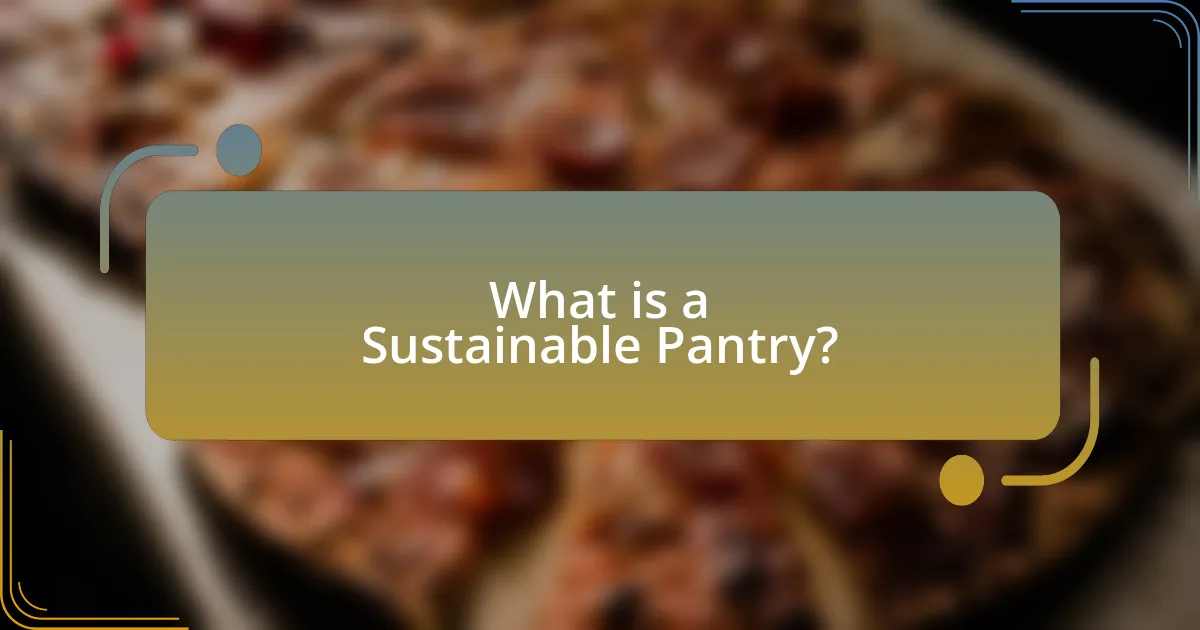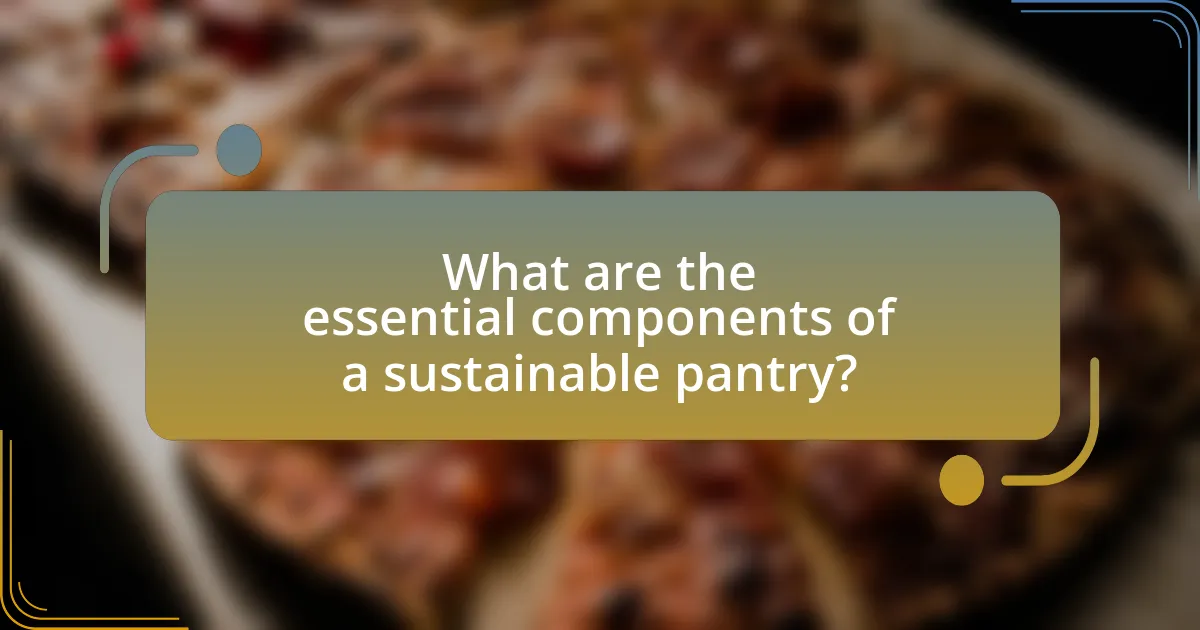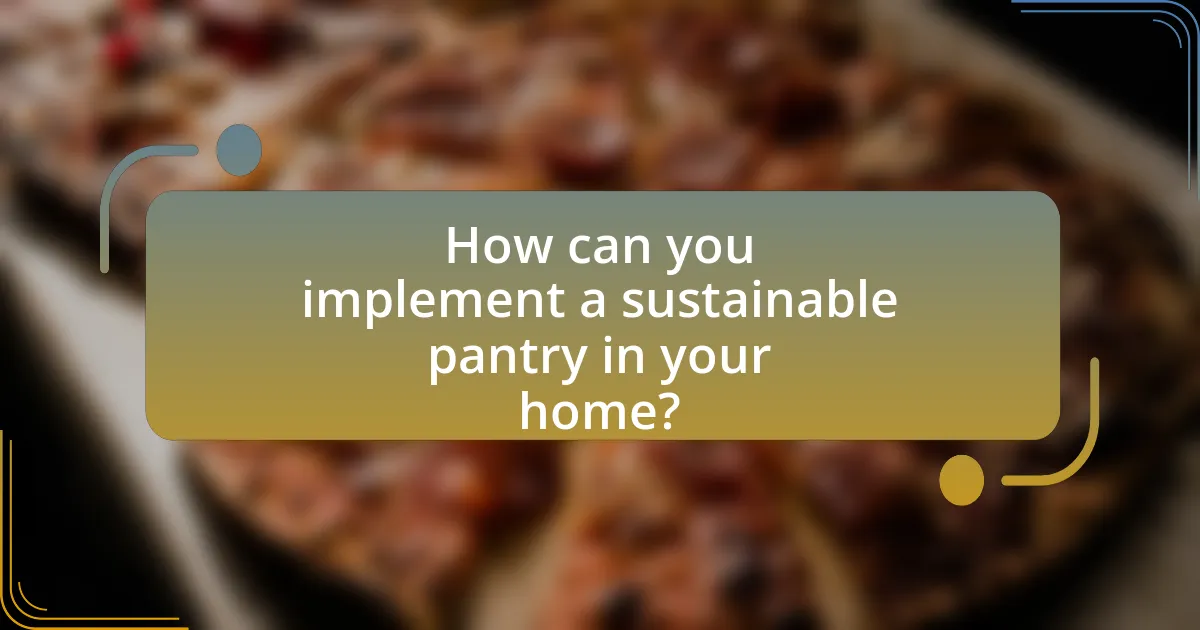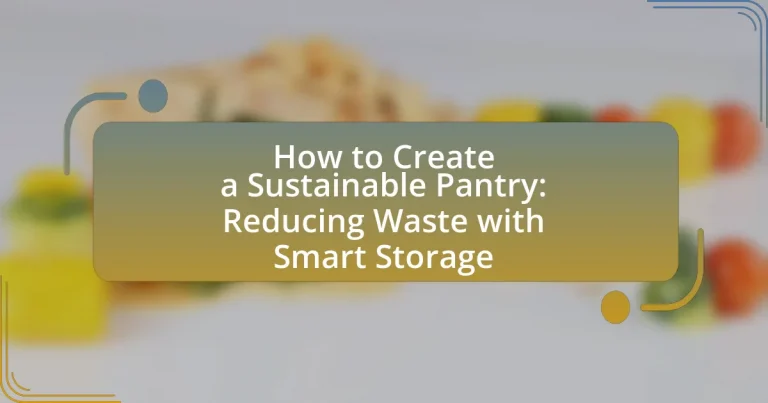A sustainable pantry is a collection of food and household items that prioritizes environmentally friendly practices, such as reducing waste and sourcing local and organic products. This article outlines the principles of sustainable pantry management, including minimizing food waste, optimizing storage conditions, and utilizing effective food preservation methods. It discusses the environmental benefits of reducing pantry waste, the impact of organization and smart storage solutions, and practical steps for implementing a sustainable pantry at home. Additionally, it addresses common challenges and offers strategies for effective inventory management, ultimately promoting a healthier lifestyle and a reduced carbon footprint.

What is a Sustainable Pantry?
A sustainable pantry is a collection of food and household items that emphasizes environmentally friendly practices, such as reducing waste, sourcing local and organic products, and utilizing reusable containers. This approach not only minimizes the carbon footprint associated with food production and transportation but also encourages mindful consumption and preservation of resources. Research indicates that sustainable food systems can significantly lower greenhouse gas emissions, with local sourcing reducing transport emissions by up to 50%.
How does a sustainable pantry contribute to reducing waste?
A sustainable pantry contributes to reducing waste by promoting the use of non-perishable, bulk, and seasonal foods, which minimizes reliance on single-use packaging and short-lived products. By focusing on items that have a longer shelf life and can be purchased in larger quantities, individuals can decrease food spoilage and packaging waste. Research indicates that approximately 30-40% of the food supply in the United States is wasted, and a sustainable pantry approach can significantly mitigate this issue by encouraging meal planning and proper storage techniques, ultimately leading to a reduction in overall waste generated.
What are the key principles of sustainability in pantry management?
The key principles of sustainability in pantry management include minimizing food waste, optimizing storage conditions, and prioritizing local and organic products. Minimizing food waste involves careful inventory management and utilizing items before they expire, which can reduce the environmental impact associated with food disposal. Optimizing storage conditions, such as maintaining appropriate temperatures and humidity levels, helps prolong the shelf life of pantry items, thereby reducing the need for frequent purchases. Prioritizing local and organic products supports sustainable agriculture practices and reduces carbon footprints associated with transportation. These principles collectively contribute to a more sustainable pantry management approach.
How does food storage impact sustainability?
Food storage significantly impacts sustainability by reducing food waste and conserving resources. Effective food storage techniques, such as proper refrigeration and airtight containers, extend the shelf life of perishable items, thereby minimizing spoilage. According to the Food and Agriculture Organization, approximately one-third of all food produced globally is wasted, which contributes to unnecessary greenhouse gas emissions and resource depletion. By optimizing food storage, households can decrease waste, leading to a more sustainable food system and reduced environmental impact.
Why is it important to create a sustainable pantry?
Creating a sustainable pantry is important because it minimizes food waste and promotes environmental responsibility. A sustainable pantry encourages the use of local, seasonal ingredients, which reduces the carbon footprint associated with transportation and supports local economies. According to the Food and Agriculture Organization, approximately one-third of all food produced globally is wasted, contributing to greenhouse gas emissions. By implementing smart storage techniques and prioritizing sustainable practices, individuals can significantly reduce waste and contribute to a healthier planet.
What environmental benefits come from reducing pantry waste?
Reducing pantry waste leads to significant environmental benefits, primarily by decreasing greenhouse gas emissions. When food waste decomposes in landfills, it produces methane, a potent greenhouse gas that contributes to climate change. According to the Environmental Protection Agency, food waste accounts for approximately 24% of municipal solid waste, which highlights the potential for reducing emissions through effective waste management. Additionally, minimizing pantry waste conserves resources such as water, energy, and labor used in food production, thereby promoting sustainability. For instance, the Food and Agriculture Organization estimates that about 1,800 liters of water are required to produce just one kilogram of beef; reducing waste helps to alleviate the strain on these vital resources.
How does a sustainable pantry affect personal health and well-being?
A sustainable pantry positively affects personal health and well-being by promoting the consumption of whole, nutrient-dense foods while reducing exposure to harmful additives and preservatives. Research indicates that diets rich in whole foods, such as fruits, vegetables, whole grains, and legumes, are associated with lower risks of chronic diseases, including obesity, diabetes, and heart disease. Additionally, a sustainable pantry encourages mindful eating practices, which can enhance mental well-being by fostering a greater connection to food sources and reducing stress related to food waste. Studies show that individuals who engage in sustainable eating habits report higher levels of satisfaction and overall well-being, as they contribute to environmental health while nourishing their bodies.

What are the essential components of a sustainable pantry?
The essential components of a sustainable pantry include non-perishable foods, bulk items, seasonal produce, and eco-friendly storage solutions. Non-perishable foods, such as grains, legumes, and canned goods, provide long shelf life and reduce food waste. Bulk items, like nuts and seeds, minimize packaging waste and allow for purchasing only what is needed. Seasonal produce supports local agriculture and reduces carbon footprint. Eco-friendly storage solutions, such as glass jars and reusable containers, help maintain food freshness while minimizing plastic use. These components collectively contribute to a sustainable pantry by promoting waste reduction and environmentally conscious choices.
How can smart storage solutions enhance pantry sustainability?
Smart storage solutions enhance pantry sustainability by optimizing space and reducing food waste. These solutions, such as airtight containers and modular shelving, help maintain food freshness and organization, which minimizes spoilage. Research indicates that organized pantries can lead to a 20% reduction in food waste, as users can easily track inventory and expiration dates. Additionally, smart technology, like inventory management apps, allows users to monitor stock levels and receive alerts for items nearing expiration, further promoting sustainable consumption practices.
What types of containers are best for reducing waste?
Reusable containers are the best for reducing waste. These include glass jars, stainless steel containers, and silicone bags, which can be used multiple times and help minimize single-use plastic waste. According to a study by the Environmental Protection Agency, reducing single-use plastics can significantly decrease landfill contributions, as plastics account for about 12% of municipal solid waste. By opting for durable, reusable containers, individuals can contribute to a more sustainable pantry and reduce their overall environmental impact.
How does organization play a role in a sustainable pantry?
Organization is crucial in a sustainable pantry as it maximizes space efficiency and minimizes food waste. By categorizing items and implementing a first-in, first-out system, individuals can ensure older products are used before newer ones, reducing spoilage. Studies show that organized pantries lead to better inventory management, which can decrease the likelihood of purchasing unnecessary items, thus promoting sustainability. Furthermore, clear labeling and designated spaces for different food types facilitate easy access and encourage mindful consumption, reinforcing sustainable practices in daily life.
What food preservation methods can be utilized?
Food preservation methods that can be utilized include canning, freezing, drying, fermenting, and vacuum sealing. Canning involves sealing food in jars and heating them to kill bacteria, which can extend shelf life for years. Freezing preserves food by slowing down enzyme activity and microbial growth, maintaining nutritional value. Drying removes moisture from food, inhibiting spoilage, and is one of the oldest preservation methods. Fermenting uses beneficial bacteria to convert sugars into acids, enhancing flavor and shelf life. Vacuum sealing removes air from packaging, reducing oxidation and spoilage. Each method effectively extends the longevity of food, contributing to a sustainable pantry by minimizing waste.
How do different preservation techniques impact food waste?
Different preservation techniques significantly reduce food waste by extending the shelf life of perishable items. Techniques such as canning, freezing, and dehydration inhibit microbial growth and enzymatic reactions that lead to spoilage. For instance, freezing can preserve food for months, reducing the likelihood of waste compared to fresh produce that may spoil within days. According to the USDA, proper freezing can maintain food quality for up to a year, effectively minimizing waste. Additionally, canning can preserve fruits and vegetables for years, allowing consumers to utilize seasonal produce year-round without waste. Overall, these techniques not only enhance food longevity but also contribute to more sustainable consumption patterns by decreasing the volume of discarded food.
What are the best practices for storing perishable items?
The best practices for storing perishable items include maintaining appropriate temperatures, using airtight containers, and regularly checking for spoilage. Proper refrigeration slows down the growth of bacteria and extends the shelf life of items; for example, keeping the refrigerator at or below 40°F (4°C) is essential for food safety. Airtight containers prevent moisture and air exposure, which can lead to spoilage; studies show that items stored in such containers last significantly longer. Additionally, routinely inspecting perishable items for signs of spoilage, such as discoloration or off-odors, helps minimize waste by ensuring that items are consumed before they go bad.

How can you implement a sustainable pantry in your home?
To implement a sustainable pantry in your home, focus on organizing and stocking it with eco-friendly products while minimizing waste. Start by using glass or metal containers for storage, which are reusable and reduce reliance on plastic. Incorporate bulk buying of grains, nuts, and spices to decrease packaging waste, as studies show that bulk purchasing can reduce plastic use by up to 67%. Additionally, prioritize local and seasonal foods to support sustainable agriculture and reduce carbon footprints associated with transportation. Regularly check expiration dates and practice the first-in, first-out method to ensure food is consumed before it spoils, which can help reduce food waste significantly.
What steps should you take to start creating a sustainable pantry?
To start creating a sustainable pantry, begin by assessing and organizing your current food items to eliminate waste. This involves checking expiration dates, discarding expired products, and donating items you won’t use. Next, prioritize purchasing bulk items and local produce to reduce packaging waste and support local economies. Incorporate reusable containers for storage to minimize single-use plastics. Additionally, plan meals to utilize ingredients efficiently, reducing the likelihood of spoilage. Research indicates that meal planning can decrease food waste by up to 50%, highlighting its effectiveness in sustainable practices.
How can you assess your current pantry for waste reduction opportunities?
To assess your current pantry for waste reduction opportunities, start by conducting a thorough inventory of all items, noting expiration dates and usage frequency. This process allows you to identify products that are nearing expiration or have not been used, which can lead to waste. Research indicates that approximately 30-40% of the food supply in the United States is wasted, highlighting the importance of regular pantry assessments to minimize this issue. By categorizing items into groups such as “use soon,” “donate,” or “compost,” you can make informed decisions on how to utilize or dispose of food effectively, ultimately reducing waste and promoting a more sustainable pantry.
What strategies can help in transitioning to a sustainable pantry?
To transition to a sustainable pantry, focus on incorporating bulk buying, choosing local and seasonal products, and minimizing packaging waste. Bulk buying reduces packaging and often lowers costs, while local and seasonal products support local economies and reduce carbon footprints associated with transportation. Research indicates that purchasing local food can cut greenhouse gas emissions by up to 50% compared to imported goods. Additionally, implementing smart storage solutions, such as using glass containers and proper labeling, can help reduce food waste by keeping items fresh longer and making it easier to track expiration dates.
What common challenges might you face when creating a sustainable pantry?
Common challenges when creating a sustainable pantry include sourcing local and organic ingredients, managing food waste, and ensuring proper storage to maintain freshness. Sourcing local and organic ingredients can be difficult due to limited availability and higher costs compared to conventional products. Managing food waste is a significant challenge, as it requires careful planning and inventory management to avoid spoilage. Additionally, ensuring proper storage involves understanding the best practices for different food types to extend shelf life, which can be complex and requires knowledge of various preservation methods.
How can you overcome obstacles related to food storage?
To overcome obstacles related to food storage, implement proper organization and utilize appropriate containers. Effective organization involves categorizing food items by type and expiration date, which helps in managing inventory and reducing waste. Using airtight containers prevents spoilage and pest infestations, ensuring food remains fresh longer. Research indicates that proper food storage can extend the shelf life of perishable items by up to 50%, thereby minimizing waste and promoting sustainability in pantry management.
What solutions exist for managing pantry inventory effectively?
Solutions for managing pantry inventory effectively include using inventory management apps, implementing a first-in, first-out (FIFO) system, and maintaining a well-organized storage space. Inventory management apps, such as Pantry Check or Out of Milk, allow users to track items, set reminders for expiration dates, and generate shopping lists, enhancing efficiency and reducing waste. The FIFO system ensures that older items are used before newer ones, minimizing spoilage and waste. Additionally, organizing the pantry by grouping similar items and labeling containers helps users quickly locate products, further optimizing inventory management.
What are some practical tips for maintaining a sustainable pantry?
To maintain a sustainable pantry, prioritize purchasing bulk items to reduce packaging waste and select organic or locally sourced products to support sustainable agriculture. Bulk buying minimizes single-use packaging, which contributes significantly to landfill waste; according to the Environmental Protection Agency, packaging accounts for about 30% of municipal solid waste. Additionally, using glass jars or reusable containers for storage helps preserve food freshness and reduces reliance on disposable materials. Implementing a first-in, first-out system ensures older items are used before newer ones, minimizing food spoilage and waste. Regularly auditing pantry contents can help identify items that need to be consumed soon, further reducing waste.
How can meal planning contribute to a sustainable pantry?
Meal planning contributes to a sustainable pantry by optimizing food usage and minimizing waste. By planning meals in advance, individuals can purchase only the necessary ingredients, reducing the likelihood of overbuying and spoilage. Research indicates that meal planning can decrease food waste by up to 50%, as it encourages the use of perishable items before they expire. This strategic approach not only conserves resources but also promotes mindful consumption, leading to a more sustainable pantry.
What are the best practices for regularly reviewing pantry contents?
The best practices for regularly reviewing pantry contents include conducting a monthly inventory, checking expiration dates, and organizing items by category. Monthly inventory helps identify what items are present and what needs to be used soon, reducing waste. Checking expiration dates ensures that expired items are discarded, maintaining food safety and quality. Organizing items by category, such as grains, canned goods, and spices, facilitates easier access and encourages the use of older items first, which aligns with the principles of a sustainable pantry. These practices collectively contribute to efficient pantry management and waste reduction.


